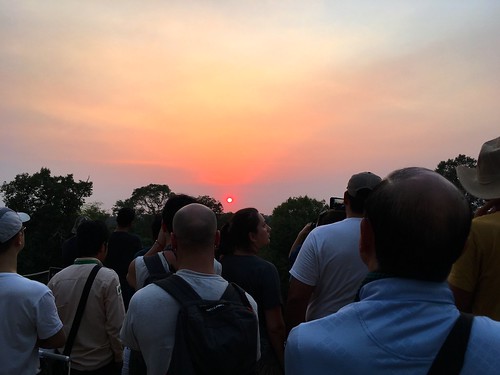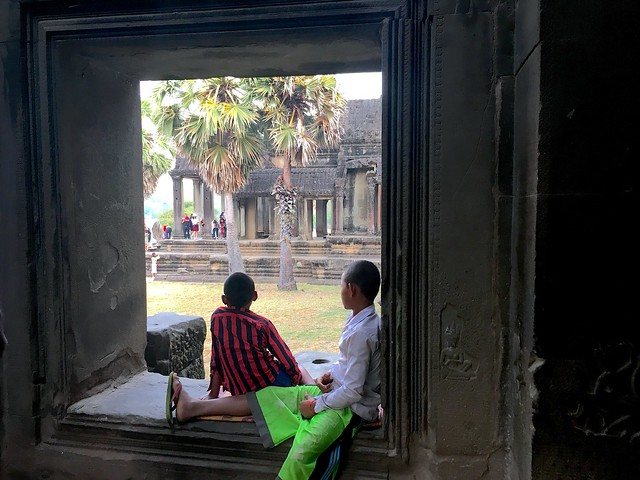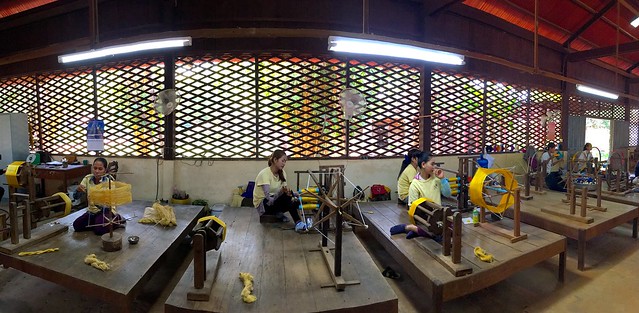Thinking of Cambodia, a warm orange glow comes to mind. Its hot and humid air, permeated with the smog of burnt leaf litter and trash at all times of the day, laced with a particularly heavy and thick acrid smell. As a side effect, the sunrises and sunsets are particularly beautiful. But during the day, if you have your helmet visor down tight, the floating ash makes you feel as you are trapped in a snow globe of a lost civilization, rebuilding itself after a troubled past.
View from our hotel balcony, the Mingalar Inn
Most budget backbackers travel from Bangkok to Siem Reap via overnight bus, it’s relatively cheap, probably won’t kill you, and can lead to some very interesting stories crossing the infamous land border between Thailand and Cambodia. As all of the buses the next day were sold out, we were forced to book a rather expensive flight (in relative terms) and wake up before the crack of dawn to make our way to the airport. We may have misjudged our timings a bit trying to save a few bucks by taking the BTS train to the airport instead of a private taxi, which lead to the inevitable mad dash across the airport to make our flight. Every travel story has to have one – hopefully not two. Arriving at the polished Siem Reap airport was rather pleasant and lovely in an oddly manicured, fresh way that is at odds with the dry landscape we just flew over. It’s definetly a door to the country designed for well heeled foreign tourists – not an airport used by local people, ever. Taxi rides into town are capped at a flat ($7) so there is no haggling involved, which was a nice introduction into the craziness that followed.
Cows are everywhere, literally everywhere.
money talks
The official currency in Cambodia is the riel (៛), but the country has been largely ‘dollarized’, so most of our transactions were in American dollars ($), including our ‘visa on arrival’. The exchange rate is ៛4000 to $1 – most items for purchase are rounded to the nearest dollar, making Cambodia a bit more expensive than Thailand, because you’re not going to get a $0.50 beer, you get a $1 beer. When you do get change, though, it isn’t in quarters, it’s in riel – e.g. paying for a ៛15000 ($3.75) item with $4 gets you a ៛1000 note back. While we were there no one could tell us why the US dollar became the default currency there – the Cambodian relationship with the US hasn’t been particularly friendly in the past – with massive carpet bombing of Cambodia by US forces during the Vietnam War and all, combined with the arguments that such action boosted recruitment success of the Khmer Rouge.
Later we picked up some light reading, an IMF working paper, (Dollarization in Cambodia: Causes and Policy Implications by Nombulelo Duma). In summary: the riel was reintroduced after the Khmer Rouge (during which there was no currency), but it didn’t take off immediatly, and dollars (and rice, and gold) were used since that’s what folks had on hand. More dollars came in with the tourists, and the tourist economy is stronger than the rural, riel based economy. Now the Cambodian economy is 90% on the dollar. The local government is trying to rein this back to give them some influence on econonmic stimulus, but with Vietnam and Thailand nipping at their borders they have bigger problems on thier hands.
angkor
Unlike Bangkok, Siem Reap feels like what an old west boom town must have felt like in the American West – dry, hot, and dusty, and with a bustling economy around transient outsiders who want to drink, party, and exploit the local ecology. Instead of gold in the ground there, it’s the Angkor temple city that draws the crowds.
West Gate of Angkor Thom, our guide said it was the gate that convicts and prisoners of war who were banished from the city of Angkor Thom used, but the internet has not corroborated this yet.
It’s a UNESCO World Heritage site, and for good reason. Like Manchu Picu, the Egyptian Pyramids, and Stonehenge, it’s a massive testament to the building power and prowess of past civilizations. Prices rose the week before we got there from $20 for a day ticket to $37. (Fun fact, none of that ticket money goes back to Cambodia – a Vietnamese company has a 99 year lease on the temples, and they have ~80 years left. A point of contention with the local Cambodian people and their current PM.) Pro tip: if you buy your tickets between 4:30 and 5pm, they’ll let you into the complex that evening to catch the sunset, but your ticket is still good for the next day.
Pre Rup at sunset
sunset
Avoding the massive crowds that usually congregate around the left moat of Ankor Wat, we instead elected to perch ourselves on the steps the smaller temple Pre Rup. We were rewarded with a small group of dedicated photographers, off-beat tourists, and a generally friendly atmosphere of locals selling cold Ankor beer at the bottom of the steps after the lengthly climb.
Pre Rup, and many of the temples, are guarded by lion statues, but most of them have been literally defaced as the call of the antiquities market incentivizes locals to chisel off elaborate stonework.
The folks at the top of Pre Rup at sunset
sunrise
The next day, we woke up at at 3:30a to join the Angkor Sunrise Discover bike tour with Grasshopper Adventures. By bus, we drove right outside of the main temple of Ankor Wat and watch the sun slowly rise over the beautiful ruins. We were pleased to be far away from the tuk-tuks, tour buses, and normal crowds that pack themselves in the get the sun rise right over the main temple. From afar, armed with fresh mango and coffee candy, we captured one of our favorite shots as the skies changes from sky blue, to deep orange, and finally velvety purple.
Angkor Wat at sunrise
Gotta get that 'gram
As the sunrise crowds headed back to their hotels for breakfast (most tour packages look like: bus out, sunrise, bus back to hotel, bus back for tour), we walked over the massive moat on a stone bridge big enough for many elephants to walk abreast towards the temple. The Angkor Wat temple is enormous, with many entrances depending on who you were, and whether or not you needed to squeeze your elephant through. Angkor (the massive city complex, which was the largest pre-industrial city in the world, supporting over a million people) is often confused with Angkor Wat (the temple). The UNESCO World Heritage site is actually a sprawling 400 square kilometers where people still live and farm between the ruins. Angkor Wat was not a part of the city that people lived in, which is why it still exists – stone buildings were for gods, wooden buildings for humans, and the wooden buildings have long since become jungle soil.
Local kids watching the tourists in Angkor Wat
We then spent the next eight hours mountain biking through the jungle, visiting local villages who live within the Angkor city limits. After exhilarating rides through jungle tracks, we were treated with temples largely devoid of tourists as they retreated back to their hotels on air-conditioned buses and to drink cheap beer with tuk-tuk drivers.
We will say this – if you go to see Ankor Wat, there is no better way to see the city than by bicycle. It keeps you active and takes you farther off the beaten path – there are little villages inside of the Angkor complex, and our route took us between the rice paddies and homes on our way to the next temple. Granted, the Grasshopper tour was far more expensive than other tours offered in the area, you can hire a tuk-tuk driver to cart you around for $10 a day as opposed to the $75/person we spent, but it’s worth every penny and very professionally organized. From ice cold mineral water offered at every stop, to a private lunch served in the jungle where we fought off monkeys stealing our mangos and bread, it was by far one of our most enjoyable tours in Southeast Asia by far.
Also, since it was a small tour, we got a lot of time with our guide, who was an absolute gem. Smart and a bit sassy, he talked to us at length about the politics in Cambodia (while we were there, the leader of the opposition party resigned and legislation was announced that solidifies the effective one party system in Cambodia), exactly what young people in that country were not hoping for. He also had a deep knowledge about the areas and temples we were visiting – he said that to become a tour guide takes a couple months of classes and then a government test, but to be a good tour guide, you must be constantly reading and continuing to learn. He also introduced us to the “Japanese Buffalo,” a Japanese made power tiller, and the “American Elephant,” a John Deere tractor – and taught us a lot about how to hunt snakes.
Biking around one of the many temple moats
restoration
The temples at Angkor have been in some state of pro-active restoration since the 1980s – and they’ve literally collected all the rubble, taken apart what remains of the temples, and rebuilt them like giant puzzles. Over the decades, various international teams have come in to excavate, study, and rebuild the temples, and you can see work happening all around.
Technically the temples have been being restored since “discovered” by the French in 1860 (discovered like Columbus discovered America), but more recent restoration projects do not have the same colonial overtones.

Rocks piled during restoration work

Local stone masons cutting new blocks for restoration work in Ta Prohm
around siem reap
Exhausted from the long day of biking, we went to bed early and putzed around town the next day, going on a free tour of the local artisan village about a half-hour bus ride out of town. The Artisan Association trains local, typically poor and uneducated Cambodians, to become skilled artisans, crafting ceramics, jewelry, fabrics, and weaving. We were particularly interested in silk production and were taken through each stage of the process, from the cultivation of the silk worms, to the separation of “raw silk” from “fine silk”, and the spinning of silk fibers into silk thread. The most impressive was the silk weavers creating complex geometrics patterns into fabrics using a foot pedal loom, handling hundreds of delicate silk bobbins of many different colors to build the patterns from memory.
Prepping the yellow silk (from the yellow silk worms) for washing and dyeing
Cambodia is a country rebuilding itself after the devastation of the Khmer Rouge. Many of the “elites” – doctors, professors, bankers, and the formally educated were sent to “learn more and be happy” at S-21, an old school turned into a make-shift prison and torture chamber, or any of the hundreds of similar sites around the country. There they forced confessions from those deemed enemies of the Khmer Rouge. Of the 20,000 people who entered there S-21, only seven where know to have survived. It is now the Cambodian Genocide Museum and is well worth is a visit if you find yourself in Phenom Penh. And don’t skip the audio tour.
Citizens who were not sent to camps like S-21 were forcefully relocated into the rural areas and assigned to government work teams, shuffled around doing hard labor to create a “idealized classless agrarian society”. This created an intellectual and educational vaccuum that the country it’s still recovering from. Recently, many non-profits have sprung up to help lift the local population out of poverty by giving them skills in the ‘modern’ economy, which in the urban areas is tourism, and preserving traditional skills in the rural areas, which, in the end, still goes back in tourism because that is who buy these products.
After the silk farm tour, we saw Phare, the Cambodian Circus. It’s pretty heavily advertised, and we are wary of heavily advertised attractions (logic being that Disneyland at home is also heavily advertised, and it’s not our cup of tea), but it was amazing. The production changes every few weeks, and we saw Same Same, But Different (that phrase is a whole blog post to itself), and they put on a pretty amazing show. The show was about the locals and the tourists in Cambodia, how foreigners act in their country, and how the values of young Cambodians are diverging from their parents’. Every scene spot on, and the physical feats of the performers were phenomenal.

A moment from the Phare, the Cambodian Circus, in Siem Reap.
other highlights
- This blog by an archaelogist working in Angkor
- Vans full of coconuts – take a passenger van, take out all the seats in the back, roll down the rear window, and start tossing in coconuts until completely and ridiculously full. Sorry, was never able to grab a photo, you’ll just have to picture it in your head.
- Sister Srey – a cute, expat filled spot with good wifi and good food, on the main drag overlooking the river. We went a couple of times for lunch and to do some planning.
-
Rice paddy herb – tastes like cumin and lemongrass, found it for the first time in a cocktail at Asana (
 ), and am committed to trying to grow it at home.
), and am committed to trying to grow it at home. - The power going out on our block at 4am while we’re trying to pack out for the sunrise tour (
 ) and the ensuing chaos.
) and the ensuing chaos. - Ryan went on a run and got chased by wild dogs (
 )
) - Marum A teaching restaurant that serves delicious food in a beautiful setting. They help train disadvantaged youths (which seems to include the vast majority of young people in Cambodia) in the hospitality industry, and it was hands down the best meal we had in Cambodia, including Phnom Phen.
Some of the phenomenal stone work in Angkor Wat











